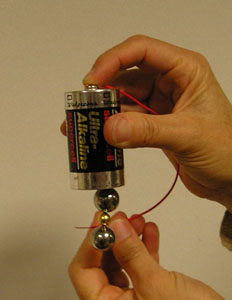
A simple motor. Click to enlarge.
Homopolar Motor

A very simple motor can be made with a battery a piece of wire a ball bearing and a magnet.
Material
A battery, for example a D-cell
A piece of wire long enough to stretch from one
terminal of the battery to the other.
Strip the ends of the wire.
Steel ball bearings
A magnet (neodymium) Spherical magnets are easiest to use, Educational Innovations, gold plated neodymium spheres.
To Do and Notice
Attach the steel ball bearing to the battery using the magnet.
Hold one end of of the wire onto the top of the battery and touch the other end lightly to the outside rim of the magnet.
Notice that the ball bearing spins.
You have created a motor.
What's Going On?
When electric current flows in a magnetic field the magnetic field exerts a force on the electric current. The direction of the force is given by the right hand rule.
If you point the fingers of your right hand in the direction of the magnetic field, assume downward in our example.(There is a 50% chance the field will point upward but this explanation still works.)
Then point your thumb (which you point at a right angle to your extended fingers) in the direction of the electric current. In this case the "conventional current" flows from the positive terminal of the battery through the wire to the negative terminal, and so it flows from the outer edge of the magnet sphere toward the pole nearest the battery.
Note, the magnet will attach itself so that one of its poles is nearest to the battery.
The force is then directed out of the palm of your hand. and so there is a push twisting the magnet around in a circle.
Here is the amazing thing. The magnetic field lines do not rotate with the rotating magnet.
So even while the magnet is rotating the electric current flows in a stationary magnetic field.
Going Further
See if you can find a combination of magnets and ball bearings and other objects that gives the most interesting motor.
|
Scientific Explorations with Paul Doherty |
|
4 May 2007 |